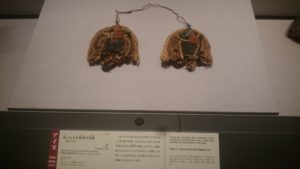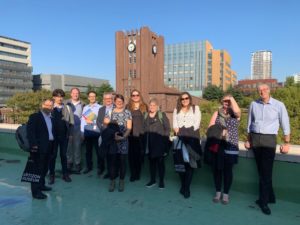Day 7 Tuesday 29 October 2019
We left Nagaoka for Tokyo, but not before there was a chance to see the town hall, designed by Kengo Kuma, who more recently designed V&A Dundee. The development is set round an open plaza, covered by an immense flat roof. Terraces, gardens, wood slats and playful angles create interlocking open spaces, bringing a variety of users into the building.
After arriving at Tokyo, the English Heritage team went to a meeting, while Sarah and I went back to the National Museum for a more leisurely look round. A real highlight was the rather animal unfriendly Ainu peoples of northern Japan who kept bears as representatives of their gods. A ceremonial head-dress was worn by the bear before it was sacrificed, using special ritual arrows. This was a stark reminder of the limits of interpreting objects to understand the beliefs and ceremonies of prehistoric people. Perhaps the amazing Marden henge arrowheads had a similar function that is now lost to us.
We then met up again as a group for a seminar at the University of Tokyo, hosted by the Cultural Heritage Management department. Susan Greaney talked about managing Stonehenge, I spoke about the challenges of running an independent museum and Sarah Simmonds outlined the thinking behind the Stonehenge and Avebury World Heritage Site Management Plan. In discussion we touched on issues such as monitoring performance, tourism and the value of international collaboration.
After a farewell cup of tea with colleagues from the University and the Jomon Culture Committee, it was time to head for the airport and the long flight home.
Reflection
The visit has been an inspirational insight into the archaeology of Japan, building understanding and sharing common issues. Our Japanese colleagues were able to show us some great achievements in interpretation and using reconstructions to bring the past to life. The close link between education and culture has helped build a real sense of pride in Jomon culture and celebration of the local. I look forward to working with our Japanese partners in 2020 on our Jomon Japan exhibition.
Postscript - July 2021
Sadly, the Coronavirus Pandemic meant that the exhibition we were planning had to be cancelled and the English Heritage exhibition postponed until 2022. We still hope to be able to lend some items from our collections to the Umtaka Jomon Museum in Nagaoka.
We are delighted that the Jomon Prehistoric Sites in Northern Japan is set to become a World Heritage Site at the July meeting of the UNESCO WHS Committee.

Niigata Town Hall - designed by Kengo Kuma, who recently designed V&A Dundee

National Museum - Ainu culture objects from Hokkaido. "During the sacrifical bear ceremony, these accessories adorned bear cubs, which were regarded as descendents of the gods." What would archaeologists make of these if found in an excavation ...

"These arrows featuring carved designs were used during the sacrifical bear ceremony. They were made for bear cubs to take with them as souvenirs to the land of the gods"

The team at Tokyo University after our seminar.

